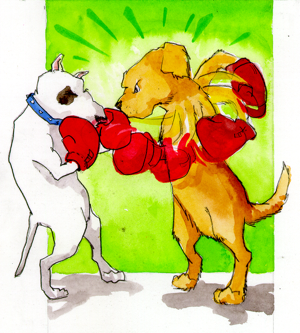Fight:Bite Ratio

An Objective Assessment of Danger of Fighting Dogs
Ian Dunbar PhD, BVetMed, MRCVS
Establish the number of full-contact fights (#Fights) plus the number of fights in which the opponent was taken to a veterinary clinic for treatment of bite wounds, i.e., fight that resulted in actual significant physical damage (#Bites).
The ratio between # Fights and # Bites indicates the level of bite inhibition and whether or not the dog is dangerous. The greater the number of fights with no damage indicates the better the dog’s bite inhibition.
Most dogs clearly fall into one of two categories — Not Dangerous or Dangerous.
Not Dangerous — Many fights but no opponent admitted to a veterinary hospital for treatment. Excellent prognosis — the dog has extremely reliable bite inhibition since it has never damaged another dog in numerous fights. The dog is unlikely to damage other dogs in future fights in the near future. The dog is not dangerous. Begin rehabilitation program immediately with oodles of classical conditioning and basic training to build the dog's confidence around other dogs. Train the dog to Come, Sit and Look at the handler on cue and reliably, to quickly diffuse escalating tension with other dogs. Rehabilitate as soon as possible because the dog is obviously stressed and walks cannot be much fun for dog or owner. The vast majority (over 95%) of fighting dogs are not dangerous.
Dangerous — Few fights but most victims require veterinary treatment. Prognosis is extremely poor since the dog routinely damages other dogs when fighting and it is time-consuming, extremely difficult and potentially dangerous to try to teach adult dogs bite inhibition towards other dogs. The dog is highly likely to damage other dogs in future fights. The dog should never be taken on to public property unless muzzled. However, walks are highly likely to be stressful for both dog and owner and so, please consider that the dog would probably be more relaxed and happy just hanging out with the human family at home.
“Gray Area” — Most dogs are obviously “not dangerous” and a few are obviously “dangerous”. However, some dogs have had several fights but have only damaged the opponent in just one or two. The prognosis is guarded. If the inflicted damage progressively worsened from fight to fight, the prognosis is not good but if damage only occurred in the first one or two fights, the prognosis is much better.
©2016 K9Games® Inc




